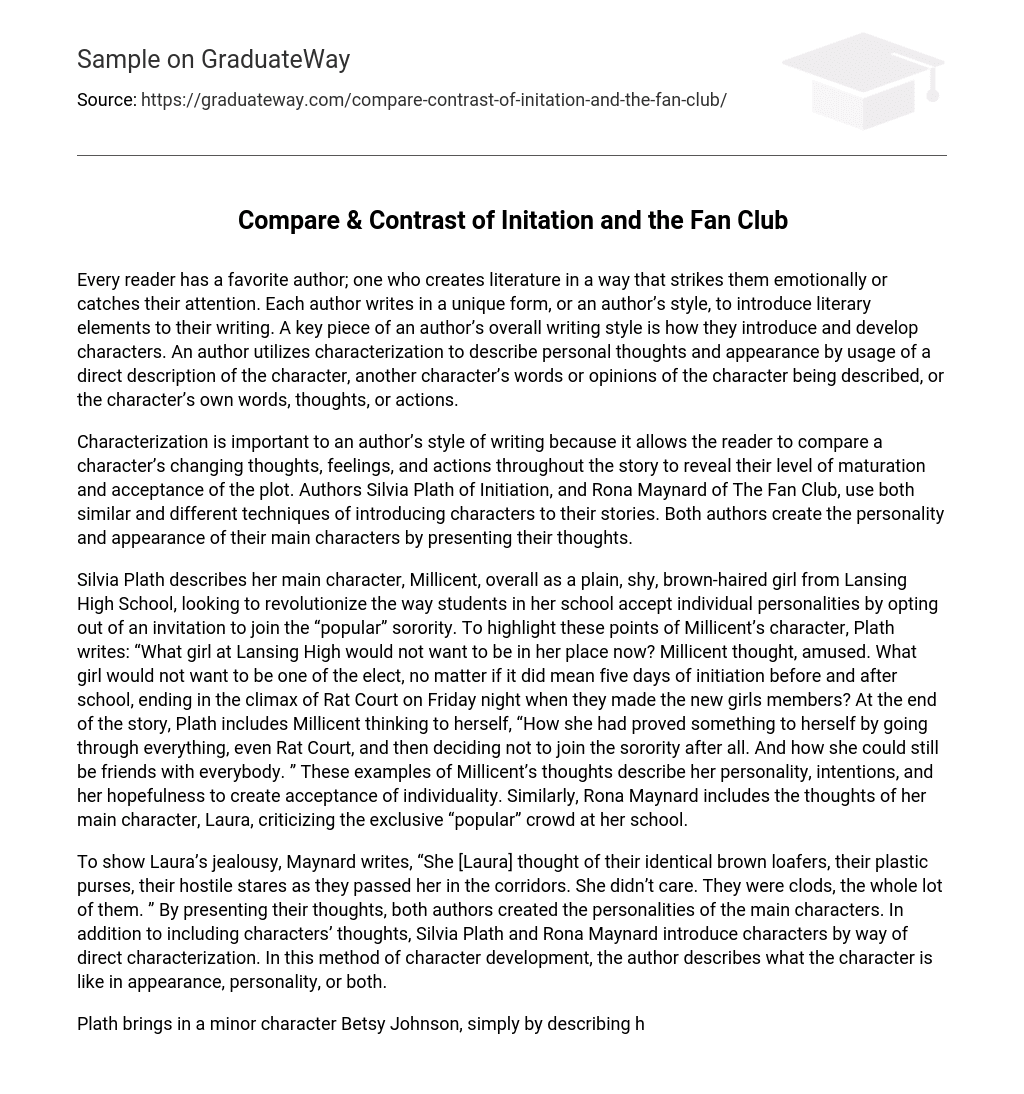Every reader has a preferred author; someone who crafts literature in a way that connects with them or piques their curiosity. Each author employs a unique approach, or style, to infuse literary elements into their writing. A crucial component of an author’s style is how they introduce and evolve characters. Characterization serves as a vital instrument that authors utilize to portray individuals, encompassing direct depictions of the character, the perspectives or remarks of other characters about the one being portrayed, or the character’s own dialogue, musings, or deeds.
Characterization is essential in an author’s writing style as it allows readers to evaluate the development of a character’s thoughts, emotions, and actions over the course of a story. This showcases their growth and comprehension of the plot. Sylvia Plath, who wrote Initiation, and Rona Maynard, who wrote The Fan Club, use similar and unique methods to introduce their characters. Both authors reveal the main characters’ qualities and physical appearance by expressing their thoughts.
In her portrayal of Millicent, the protagonist of her story, Silvia Plath characterizes her as an ordinary, introverted girl with brown hair attending Lansing High School. Millicent aims to bring about a change in her school’s attitude towards acceptance of individual personalities by declining an invitation to join the popular sorority. To emphasize these aspects of Millicent’s persona, Plath writes: “Millicent thought, amused, who at Lansing High would not desire to be in her position? Who would not yearn to be counted among the chosen ones, even if it entailed enduring a five-day initiation before and after school that climaxes with the Rat Court on Friday night when new girls are inducted?” Towards the end of the story, Plath shows Millicent reflecting on her decision with the thought: “She realized she had proven something to herself by going through everything, including Rat Court, and then deciding against joining the sorority. She also recognized that she could still maintain her friendships with everyone.” These instances of Millicent’s internal musings reveal her personality, intentions, and her optimism regarding fostering acceptance for individuality. Similarly, Rona Maynard presents Laura, her main character, voicing criticism towards the exclusive popular crowd at her school.
Both Silvia Plath and Rona Maynard use different techniques to develop their main characters. Maynard shows Laura’s jealousy by describing how she thinks about other people, saying “She [Laura] thought of their identical brown loafers, their plastic purses, their hostile stares as they passed her in the corridors. She didn’t care. They were clods, the whole lot of them.” By including these thoughts, Maynard gives insight into Laura’s personality. Similarly, Plath and Maynard both introduce characters through direct characterization, where the author describes what the character looks like or what their personality is like.
In her narration, Plath introduces a minor character named Betsy Johnson simply by describing her as “the vivacious blonde secretary of the sorority”. Similarly, Plath portrays another character, Louise Fullerton, as “pretty and dark and Vice-President of the Student Council” in high school. Likewise, Rona Maynard describes one of her main characters, Rachel Horton, as “alone as always, her too-long skirt billowing over the white, heavy columns of her legs, her freckled face ringed with shapeless black curls”. Both authors use these examples to present their characters within the story.
Plath and Maynard employ similar approaches to characterization in their novellas, but there is a distinct divergence in their works. In the conclusion of The Fan Club, Laura’s decision to participate in the bullying of the group she initially despised indicates that her initial disdain and mockery were driven by jealousy. Through Laura’s actions, Maynard reveals a character who craves acceptance and is willing to stoop to bullying her supposed friend to attain it.
While Maynard focuses on Millicent’s decision to join the sorority, Silvia Plath takes a different approach by using Millicent’s participation in the initiation ceremony to portray a positive change in her personality. In contrast to Maynard, Plath’s story does not explicitly show Millicent declining the invitation. Instead, the story ends with Millicent walking towards the place where she will receive the invitation, but she is deep in thought and resolves not to accept it.
Both Maynard and Plath employ characterization to depict their respective protagonists, Laura and Millicent. However, they diverge in their approach, leading to a distinctive writing style for each author. Despite sharing the common theme of acceptance, a comparison of these two novellas highlights how the authors’ distinct methods of character portrayal shape their unique styles in storytelling.





